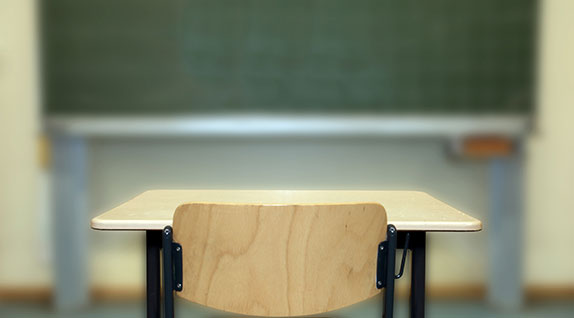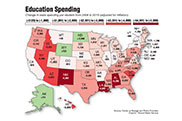 Thinkstock
Thinkstock
Article
Teachers, administrators and politicians have tried for decades to fix America’s education system. Yet the solution requires an understanding of the cause behind ineffective schooling.
Learn the why behind the headlines.
Subscribe to the Real Truth for FREE news and analysis.
Subscribe NowAfter walking through a bustling phalanx of teenagers in a hallway, you enter a warm, dimly lit, poster-filled room. A set of questions displayed on a digital interactive whiteboard prompts each pupil to transmit a response using a personal remote control, or to stand up and manually enter their answer through touch-sensitive icons on the electronic screen. As pupils complete warm-up assignments on school-provided laptop computers, attendance is silently taken using an electronic seating chart featuring each student’s digital photo, which is sent to the main office via computer network.
The usual suspects are goofing off. The teacher separates them and reminds everyone that time management is crucial.
The activities that follow have been carefully planned to require minimal lecture time, quickly shifting to hands-on experience that is strategically designed for age-specific attention spans. The dynamic format allows for much student collaboration and trial and error, with the teacher acting as a facilitator.
But actual learning seems scarce, as the lesson flow is often interrupted by gum-chewers, paper-ball throwers, disrespectful commentators, excessive chatter, missing materials, equipment vandalism, detention assignments, one-way restroom trips, students sent to the principal’s office, the occasional scuffle—or lockdowns for immediate threats such as gang fights, an armed intruder, or police inspecting lockers for illegal drugs.
The bell rings as the class period ends. Students stand up and shuffle to the next classroom. Whatever is not finished is typed up by the teacher and posted on a homework webpage.
Welcome to the 21st-century American classroom.
Here, the concept of a teacher verbally presenting information to quietly listening students is largely outdated. Modern educators now have to keep up with every technological advancement, combat ever-shortening attention spans, and generally be ready to adapt to what students want.
Despite the best efforts of teachers and school administrators, there continues to be widespread scholastic disinterest, high dropout rates, and low test scores.
What is preventing educators from delivering a “good education”?
State of the Classroom
Today’s classroom has drastically changed since years past. Sincerely dedicated teachers look for new and effective ways to make a difference in students’ lives, even if this means constantly altering established patterns or spending personal funds on whatever does not fit the school budget.
 Thinkstock
Thinkstock
Yet many do not find success with contemporary teaching methods and initiatives. The Alliance for Excellent Education reports that “teachers are leaving the profession at an alarming rate: 14 percent of new teachers leave by the end of their first year; 33 percent leave within three years; and almost 50 percent leave in five years. Estimated conservatively, American schools spend more than $2.6 billion annually replacing teachers who have dropped out of the profession. Many analysts believe that the price is actually much larger and point out that the loss in teacher quality and student achievement must be added to the bill.”
Moreover, large numbers of students also quit, creating for themselves a future with far narrower options. In the United States, “Nearly 1 million kids who start high school every year don’t make it to graduation” (NPR). This has a domino effect: “At a time when federal and state budgets are tight, dropouts costs taxpayers hundreds of billions of dollars in lost revenue, health care, welfare and incarceration costs” (ibid.).
While there are programs that attempt to counter these trends, the overall trajectory is not changing, and the public has noticed. According to a 2015 Gallup poll, only 31 percent of Americans expressed confidence in their nation’s public school system. This figure is nine percentage points lower than the historical average.
Starting at Home
While the old adage “it takes a village to raise a child” is held as the standard in modern education, some in the proverbial village are not fulfilling their part in the education endeavor.
A CNN editorial highlighted this: “I don’t know the status of parenting in America. But I know a little about the status of education in America. Parents’ growing inability to impose manners and limits on their kids when the kids are in school is reflected in record dropout rates, as well as teen drug and alcohol abuse, teen sex, and unwed pregnancies. Maybe it’s parenting that’s on the decline, more than the schools.”
Dwindling parental involvement (sometimes due to a need to work more hours to pay increasing bills) at schools is causing a shift of responsibilities, with children now virtually raised by schools—along with (after school) the Internet, television, video games, and friends.
Ultimately, a lack of parental involvement means teachers are toothless. If teachers’ standards are not reinforced at home, more than half the battle is lost.
Add to this the constantly changing approach to disciplinary action: warnings, detention, out-of-school suspension, and so on. With low parental supervision and ever-eroding respect for authority, including school officials, standards become impossible to maintain.
Despite schools’ attempts to keep up with instructional and technological trends, sophisticated teacher training, and specialized programs, something is missing. Many students continue failing and basic knowledge—even among those who graduate—has become increasingly rare.
A Huffington Post article reported: “Only 18 percent of eighth graders were proficient or better in U.S. history in 2014. They scored slightly better, on average, than the eighth graders who took the first such test in 1994—but no better than those who took the test in 2010.”

Literacy scores are not faring well either. In the latest International Adult Literacy Survey, “…between 19% and 23% of American adults performed at the top levels for each of the three literacy scales: document literacy, prose literacy and quantitative (number) literacy…Yet many Americans are being left behind. The same survey found that between 21% and 24% of U.S. adults performed at the lowest level for all three scales, a figure echoed by the National Adult Literacy Survey…”
Illiteracy has a serious impact on a country’s economy and well-being. Statistically, less-educated individuals are prone to earning lower wages, depending on government programs, and committing crimes. And in the mind of educators, it all starts in the classroom.
Serious issues such as the achievement gap, dropout rates, illiteracy, insufficient funding, and poor parenting are everyday battles in the 21st-century classroom. Are today’s school systems on the right track to conquer these problems? Or is education on a downward spiral?
Lowering Expectations
Human civilization has seen millennia of various forms of education, and most have required students to reach certain standards. Encyclopaedia Britannica states that priests in ancient Egypt and Mesopotamia “dominated the intellectual and educational domain…Methods of teaching and learning were memorization, oral repetition, copying models, and individual instruction. It is believed that the exact copying of scripts was the hardest and most strenuous and served as the test of excellence in learning. The period of education was long and rigorous, and discipline was harsh.”
Of the Incas, the article states: “The instructors were highly respected encyclopaedic scholars known as amautas. After the completion of this education, the pupils were required to pass a series of rigorous examinations in order to attain full status in the life of the Inca nobility.”
Every advanced human civilization has seen a pattern of rigor in education connected to success. More recently, the 20th century saw increased worldwide academic rigor triggered by the Soviet launching of Sputnik 1 and a resultant scientific revolution.
Conversely, a Washington Post commentary stated of today’s expectations: “…the question we should be asking ourselves about our nation’s schools is this: ‘Where’s the rigor?’ Or, ‘Where’s the academic beef?’”
Related to these questions are initiatives that lower homework standards. An example is a controversial school policy that advocates for homework to have less weight in determining grades. “Critics—mostly teachers—worry that the policy will encourage students to slack off assigned work and even reward those who already disregard assignments,” The Los Angeles Times reported. “And they say it could penalize hardworking students who receive higher marks for effort. Some educators also object to a one-size-fits-all mandate they said could hamstring teaching or homogenize it. They say, too, that students who do their homework perform significantly better than those who don’t—a view supported by research.”
How far are some educators willing to lower the bar? Consider the case of Atlanta’s standardized test scandal, which began in 2009: “Cheating occurred in 44 of the 56 Atlanta elementary and middle schools examined, and with the collusion of at least 178 teachers, including 38 principals,” The Economist reported, adding, “Answer-sheets in some classrooms found wrong-to-right erasures on test sheets that had standard deviations 20 to 50 times above the state norm…Some teachers gave pupils answers. Some filled in answers themselves. Some pointed to answers while standing over pupils’ desks. Others let low-scoring children sit near—and copy from—higher-scoring ones. One group of teachers had a test-changing party over the weekend…Governor Nathan Deal released a report that found cheating throughout Atlanta’s school system, not by pupils but by teachers, with the superintendent and her administration either encouraging it or turning a blind eye.”
Low expectations early in a pupil’s academic career have far-reaching impacts. At the college level, where professors increasingly complain of poor freshman academics, “Students are hitting the books less and partying more,” The New York Times reported. “Easier courses and easier majors have become more and more popular…What many of those students are not walking away with is something that has long been recognized as invaluable—higher order thinking and reasoning skills. They can get their degrees without putting in more of an effort because in far too many instances the colleges and universities are not demanding more of them.”
Stymied by Division
Different countries, and regions within countries, use a myriad of educational philosophies and approaches—with mixed results. Many see Finland as a model for success. In her book, The Flat World and Education – How America’s Commitment to Equity Will Determine Our Future, author Linda Darling-Hammond states: “Finland has been a poster child for school improvement since it rapidly climbed to the top of the international rankings after it emerged from the Soviet Union’s shadow. Once poorly ranked educationally, with a turgid bureaucratic system that produced low-quality education and large inequalities, it now ranks [high] among all OECD [Organization for Economic Cooperation and Development] nations on the PISA [Program for International Student Assessments, an international test for 15-year-olds] in mathematics, science, and reading. The country also boasts a highly equitable distribution of achievement, even for its growing share of immigrant students.”
By contrast, American education is sharply divided due to problems outside the classroom. Issues with teacher evaluation, tenure, funding, salaries, benefits and bargaining rights have sparked a series of protests, with ripple effects across the nation—affecting students as well.
On one hand, teachers unions are fighting to preserve collective bargaining in aspects such as teacher-salary, benefit and pension negotiation. On the other, some politicians are working on reforms to limit the influence of these organizations in a stressed economy.
Another historically insoluble issue for the system has been diversity of religious ideologies. Since prayer and Bible reading were eradicated from public schools in 1963, controversy has arisen regularly over issues such as incorporating multicultural religious holidays, banning or editing the Pledge of Allegiance’s religious language, teaching young children about homosexuality, and the infamous grapple between creation and evolution.
Failing Grade
Most teachers enter their profession to be a positive influence on their pupils. Everyone can recall those few teachers they will never forget—even decades later. These are the educators who regularly put in 14-hour days. They give their time to their pupils. They want to better their students by teaching them culture, to think critically, and to enjoy learning. They set out to instill a sense of wonder in their pupils, and to bring meaning to the world in which they live. They teach their classes to promote positive change in society.
Herein lies a problem in modern education. Even apparently selfless teachers, who devote their lives to their jobs, fail to bring lasting change. They may affect individual lives, but society as a whole continues on the same path.
Fighting for causes of change presents another problem: there is no set standard of right or wrong. Those championing differing ideals adhere to them because they came to them through intellectualism or because they feel right. But there are at least two competing camps on every issue, with little common ground.
Without a clear sense of right or wrong, mankind cannot solve its deep-rooted problems of war, famine, disease, poverty, inequality and injustice.
The goals of education and knowledge are to solve these, yet they continue to dog mankind—even grow worse. Does this make any sense?
With this point alone, modern education should get a failing grade!
Right Foundation
Primary schools, middle schools, high schools, and universities have to accept that, in all of man’s affairs, there will generally be division, dysfunction and social ills. They must build their curriculums around this fact.
Underlying many educational endeavors are attempts to explain what drives human nature. Evolutionary biology textbooks attribute it to animalistic urges. Psychology textbooks say it derives from subconscious desires. Theology textbooks say it originates from the “original sin.” Yet these books only theorize the causes of human nature, and cannot solve the problems created by mankind.
There is a complete textbook on human nature, which most overlook. That book is the Bible. Notice: “The heart is deceitful above all things, and desperately wicked: who can know it?” (Jer. 17:9). Also, “The way of peace they know not; and there is no judgment in their goings: they have made them crooked paths: whosoever goes therein shall not know peace” (Isa. 59:8).
Put together, these verses point to a bleak view of man’s nature. He is desperately wicked, and does not know how to bring peace!
The Bible goes deeper into what is called the “human condition.” While modern education fails to pinpoint a clear definition of right versus wrong, the book of Proverbs clearly states, “There is a way which seems right unto a man, but the end thereof are the ways of death” (14:12).
Humanity has always done what “seems right,” with the same failed results. It is as if a man built a house on a swamp only to have it sink into the mire upon completion. Years later, his son does the same thing—only to have his home destroyed. Then his grandson does the same. And his great-grandson…
Absurd! If this scenario were real, the first man’s son would realize his father’s mistake and not repeat it.
Amazingly, this is essentially what educators have unwittingly done for millennia. They have built on what they thought was right, but the track record of this thinking speaks for itself: wars, poverty and corruption—evil continually. (To learn more about this topic, read Did God Create Human Nature?)
The Bible alone outlines what constitutes a good education, providing the right foundation on how to overcome and avoid the problems that have always plagued mankind’s education system. Notice what God thinks of man’s attempt to govern itself: “My thoughts are not your thoughts, neither are your ways My ways, says the Lord” (Isa. 55:8).
How far apart from God are mankind’s ways—including its ways to educate? The next verse answers, “For as the heavens are higher than the earth, so are My ways higher than your ways, and My thoughts than your thoughts” (vs. 9).
Government officials, school administrators, teachers and parents must all realize that on their own they can never succeed in providing a truly good education. Without this, students do not have a chance.
The only way this could happen would be for every government and school board to admit they are wrong and follow what is outlined in the Bible—the only right foundation for education. This crucial step would unleash true knowledge and incredible wisdom the world over. Virtue—true character—would be at the core of every class lesson, which would bring true joy to students. Teachers would command students’ full respect and attention, and finally experience what is truly a noble vocation.
Rather than learning to “make a living,” humanity would be taught how to live.
To learn what a world living God’s Way would look like, read the book Tomorrow’s Wonderful World – An Inside View!
Other Related Items:
More on Related Topics:
- U.S. Children Fall Further Behind in Reading, Make Little Improvement in Math on National Exam
- Schools Are Cutting Bus Service for Children. Parents Are Turning to Ride-hailing Apps
- Is College Worth It?
- Taliban Have Deliberately Deprived 1.4 Million Afghan Girls of Schooling Through Bans, Says UNESCO



